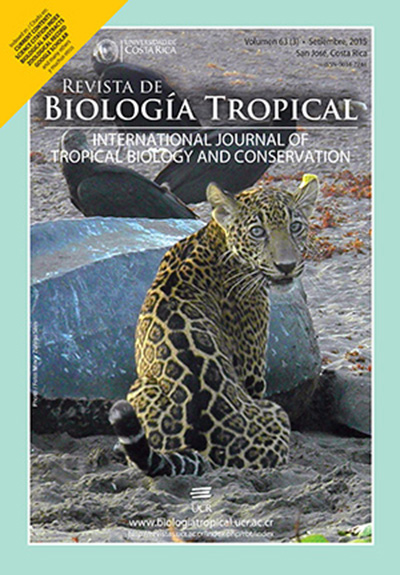Abstract
The adults and larvae of Passalidae are subsocial insects commonly found in tropical forests, living in decaying wood gallery systems constructed by adults. Currently, few repots on the larvae of Neotropical Passalidae have been published and information is scarce. In this study, the Passalus (Pertinax) gravelyi Moreira, 1922 larvae is described for the first time, based on ten larval specimens 1 (1° instar), 4 (2º instar), and 5 (3º instar) associated with three adults collected from a single colony at the Parque Nacional do Itatiaia (Itatiaia, Rio de Janeiro, Brazil). The description was carried out based on electronic and digital photographs of diagnostic structures, with some details on the systematic of the species. The larvae of Passalus gravelyi has the general setal ‘Pertinax’ pattern and differed from others by 16 to 18 setae on the anal ring, the other larvae data from Brazilian species show the anal ring with 10 to 12 setae. A discussion on the presence of sexual dimorphism in 62 species of two and three instars of Passalidae larvae is provided for the first time. Besides, a description of the terminal ampulla present as a cuticular structure found in the medial-ventral area of the 9th abdominal sternite in males is also given. The terminal ampulla was only observed in the Passalidae male larvae and was not visible in female larvae. The terminal ampulla are acknowledged now in males of 64 passalid species, that are taxonomically distributed in world tropical forests, at the Oriental and Australian subfamily Aulacocyclinae (Aulacocyclini & Ceracupini) and the cosmotropical subfamily Passalinae (Solenocyclini, Macrolinini, Passalini, & Proculini).
References
Boucher, S. (2006). Evolution et phylogénie des Coléoptères Passalidae (Scarabaeoidea). Annales de la Société Entomologique de France (Nouvelle Série), 41, 239-604.
Costa, C., & Fonseca, C. R. V. da. (1986). Larvae of Neotropical Coleoptera. XIII. Passalidae, Passalinae. Revista Brasileira de Entomologia, 30, 57-78.
Costa, C., Vanin, S. A., & Casari-Chen, S. A. (1988). Larvas de Coleoptera do Brasil. São Paulo, Brasil: Museu de Zoologia, Universidade de São Paulo.
Fonseca, C. R. V. da, & Reyes-Castillo, P. (2004). Synopsis on Passalidae family (Coleoptera: Scarabaeoidea) of Brazil with description of a new species of Veturius Kaup. 1871. Zootaxa, 789, 1-26.
Herold, M. J. O. (1815). Entwickelungsgeschichte der Schmetterlinge anatomisch und physiologisch Bearbeit. Cassel, Marburg.
Hincks, W. D., & Dibb, J. R. (1935). Coleopterorum Catalogus. Pars 142: Passalidae. Junk, Gravenhage.
Hurpin, B. (1953). Reconnaissance des sexes chez les larves de Coléoptères Scarabaeidae. Bulletin de la Société Entomologique de France, 58, 104-107.
Luederwaldt, H. (1931). Monographia dos Passalídeos do Brasil. Revista do Museu Paulista, 17, 1-262.
Martínez, M. I. (1999). Estudio de la anatomía microscópica en insectos: técnicas básicas. Folia Entomológica Mexicana, 105, 65-76.
Martínez, M. I. (2002). Técnicas básicas de anatomía microscópica y de morfometría para estudiar a los insectos. Boletín de la Sociedad Entomológica Aragonesa, 30, 187-195.
Martínez, M. I. & Lumaret, J. P. (2003). Dimorfismo sexual en las larvas de Scarabaeoidea. En G. Onore, P. Reyes-Castillo, & M. Zunino (Eds.), Scarabaeidos de Latinoamérica: el estado del conocimiento (Vol. 3). Zaragoza, España: Sociedad Entomológica Aragonesa.
Martínez, M. I., & Lumaret, J. P. (2005). Structure of the terminal ampulla in male larvae of Canthon cyanellus LeConte (Coleoptera: Scarabaeidae: Scarabaeinae). The Coleopterists Bulletin, 59, 35-39.
Matsuda, R. (1976). Morphology and evolution of the insect abdomen. Oxford: Pergamon Press.
Mattos, I., & Mermudes, J. R. M. (2013). Synopsis of Paxillus MacLeay, 1819 (Coleoptera: Passalidae): Distributional records and descriptions of four new species from Brazil. Zootaxa, 3652, 327-342.
Menees, J. H. (1957). Sex identification in some larvae of Scarabaeoidea. Bulletin of the Brooklyn Entomological Society, 52, 97-100.
Moreira, C. (1922). Coléoptères Passalides du Brésil. Annales de la Société Entomologique de France, 90, 255-294.
Onore, G. (1994). Description of the immature stages of six species of Sphaenognathus, with comparative notes on phylogeny and natural history (Insecta: Coleoptera: Lucanidae). Annals of Carnegie Museum, 63, 77-99.
Ramírez-Salinas, C., Pacheco-Flores, C., Castro-Ramírez, A. E., & Morón, M. A. (2010). Descripción de los estados inmaduros de Ligyrus nasutus (Burmeister, 1847) (Coleoptera: Melolonthidae: Dynastinae) con información sobre su biología. Acta Zoológica Mexicana (nueva serie), 26, 617-625.
Reyes-Castillo, P. (1970). Coleoptera, Passalidae: Morfología y división en grandes grupos; géneros americanos. Folia Entomológica Mexicana, 20-22, 1-240.
Reyes-Castillo, P. & Halffter G. (1984). La estructura social de los Passalidae (Coleoptera: Lamellicornia). Folia Entomológica Mexicana, 61, 49-72.
Schuster, J. C. (1983). Acoustical signals of passalid beetles: complex repertoires. The Florida Entomologist, 66, 486-496.
Schuster, J. C. (1992). Passalidae: state of larval taxonomy with description of New World species. Florida Entomologist, 75, 357-369.
Schuster, J. C., & Reyes-Castillo, P. (1981). New World genera of Passalidae (Coleoptera): a revision of larvae. Anales de la Escuela Nacional de Ciencias Biológicas, 25, 79-116.
Schuster, J. C., & Reyes-Castillo, P. (1990). Passalidae: new larval descriptions from Taiwan, Philippine Islands, Brunei and Ivory Coast. Florida Entomologist, 73, 267-273.
Snodgrass, R. E. (1941). The male genitalia of Hymenoptera. Smithsonian Miscellaneous Collections, 99(14), 1-69.
##plugins.facebook.comentarios##

This work is licensed under a Creative Commons Attribution 4.0 International License.
Copyright (c) 2015 Revista de Biología Tropical






